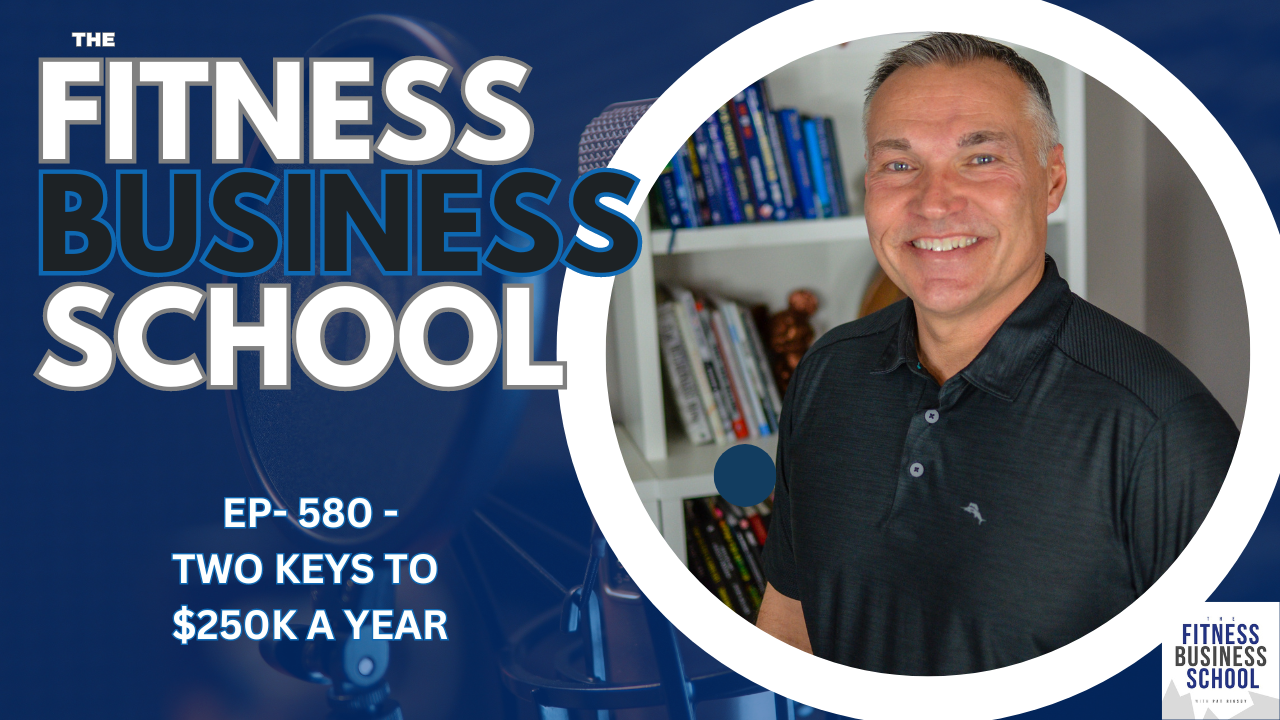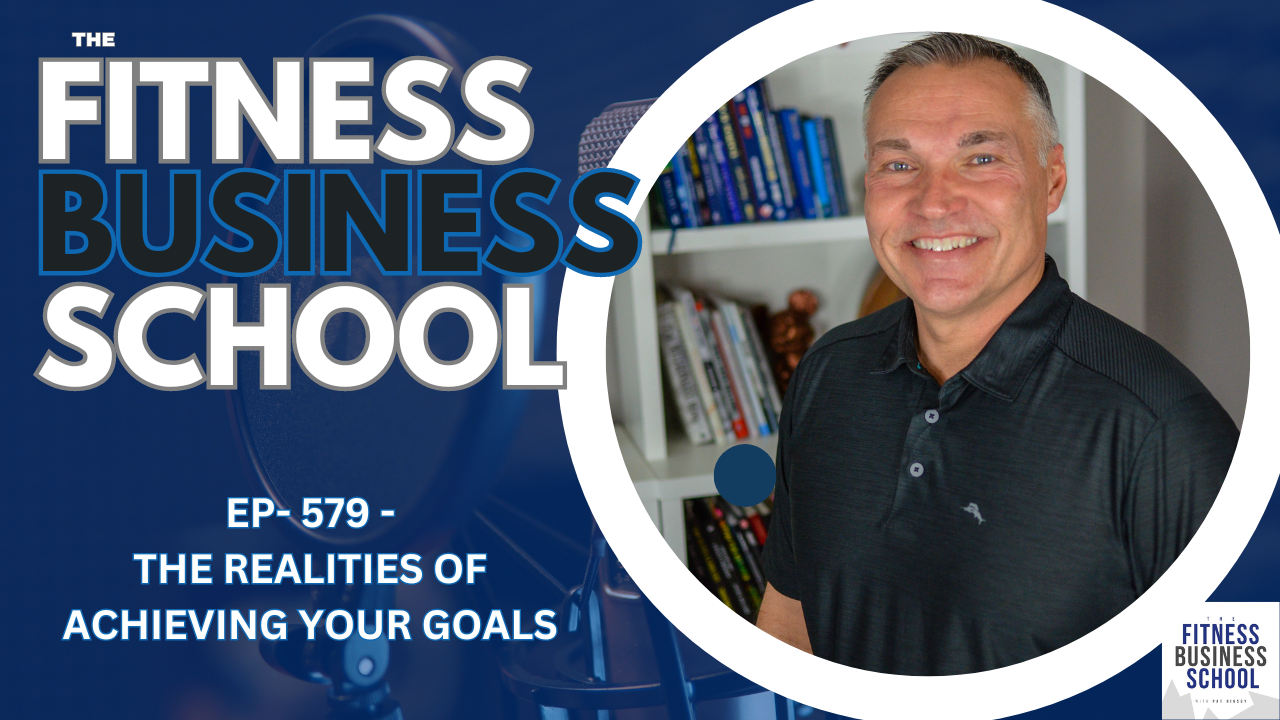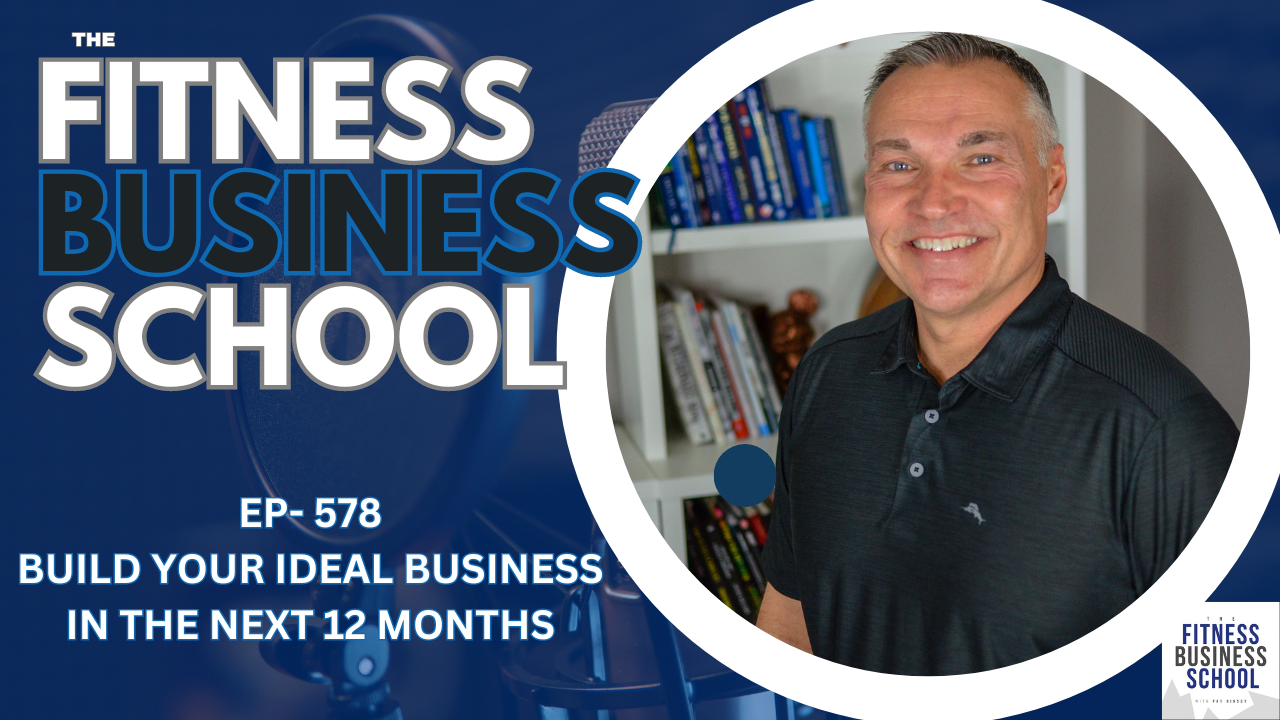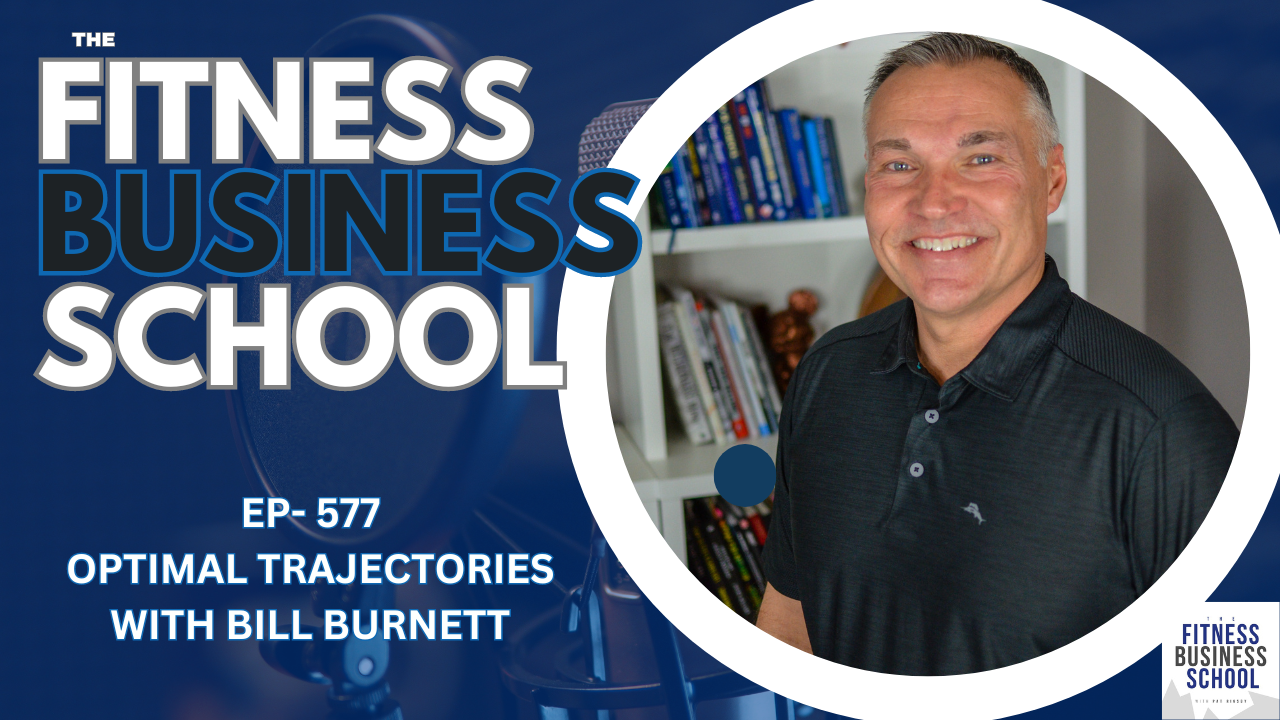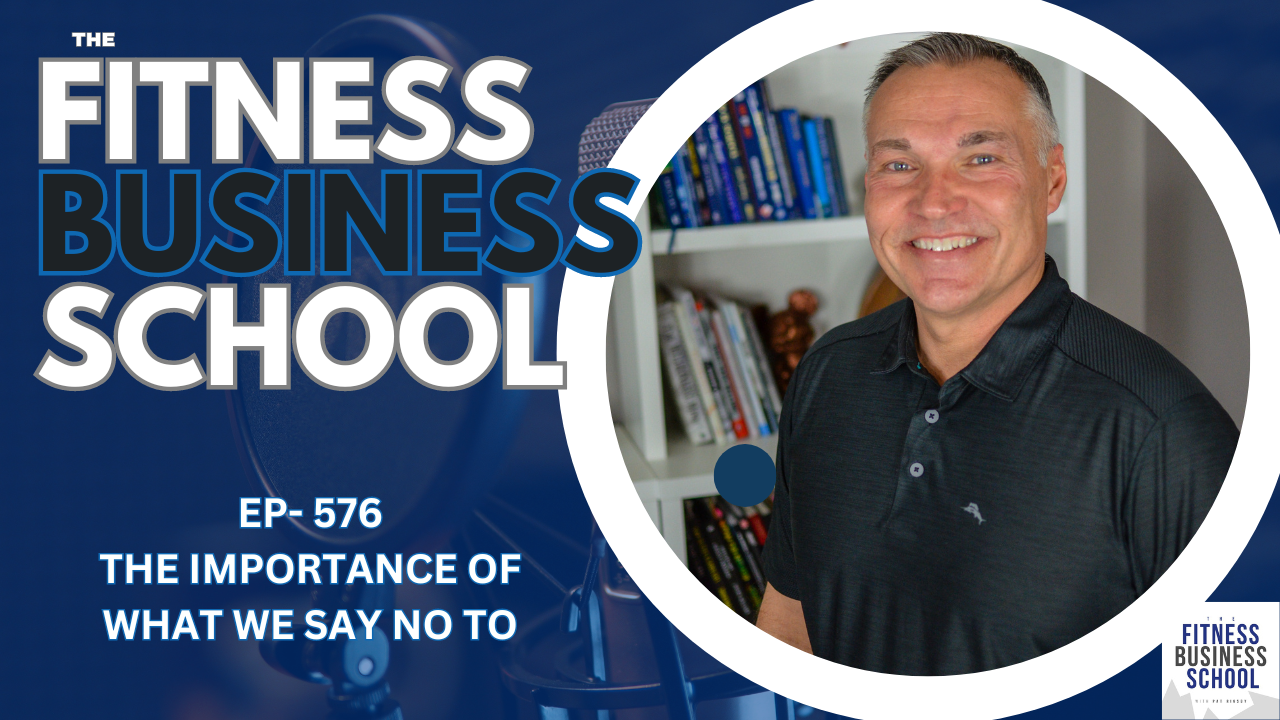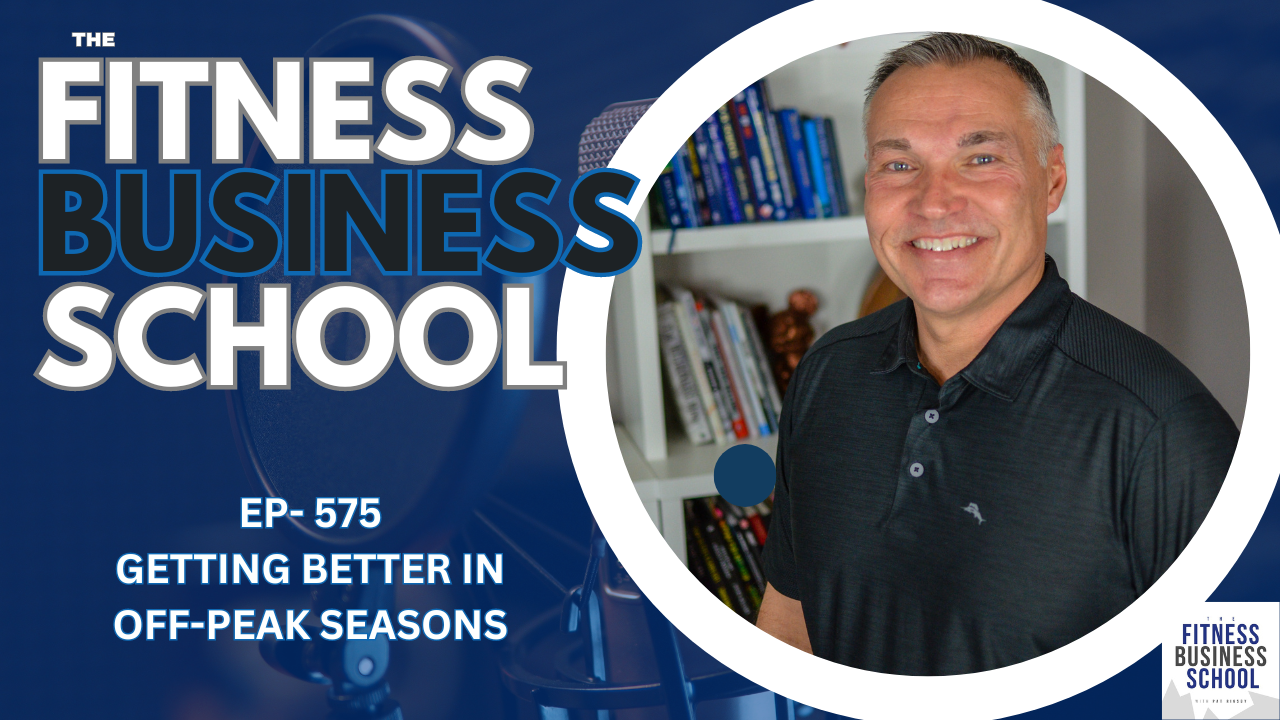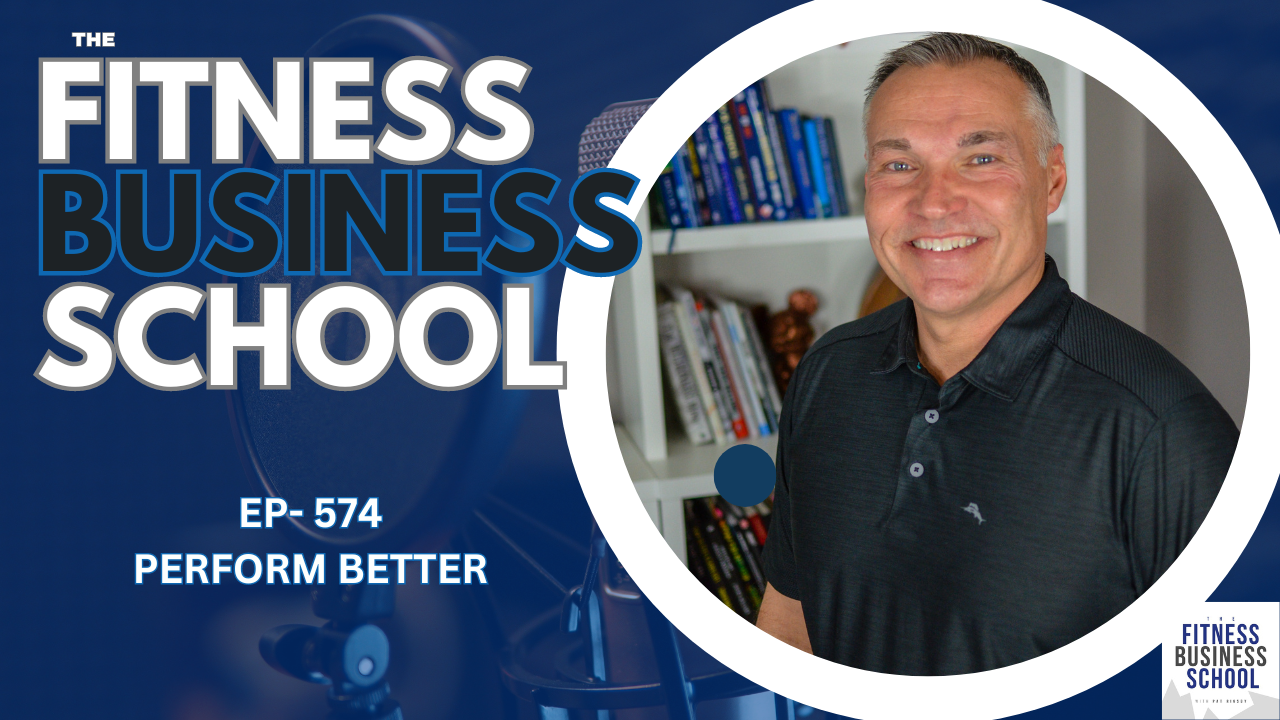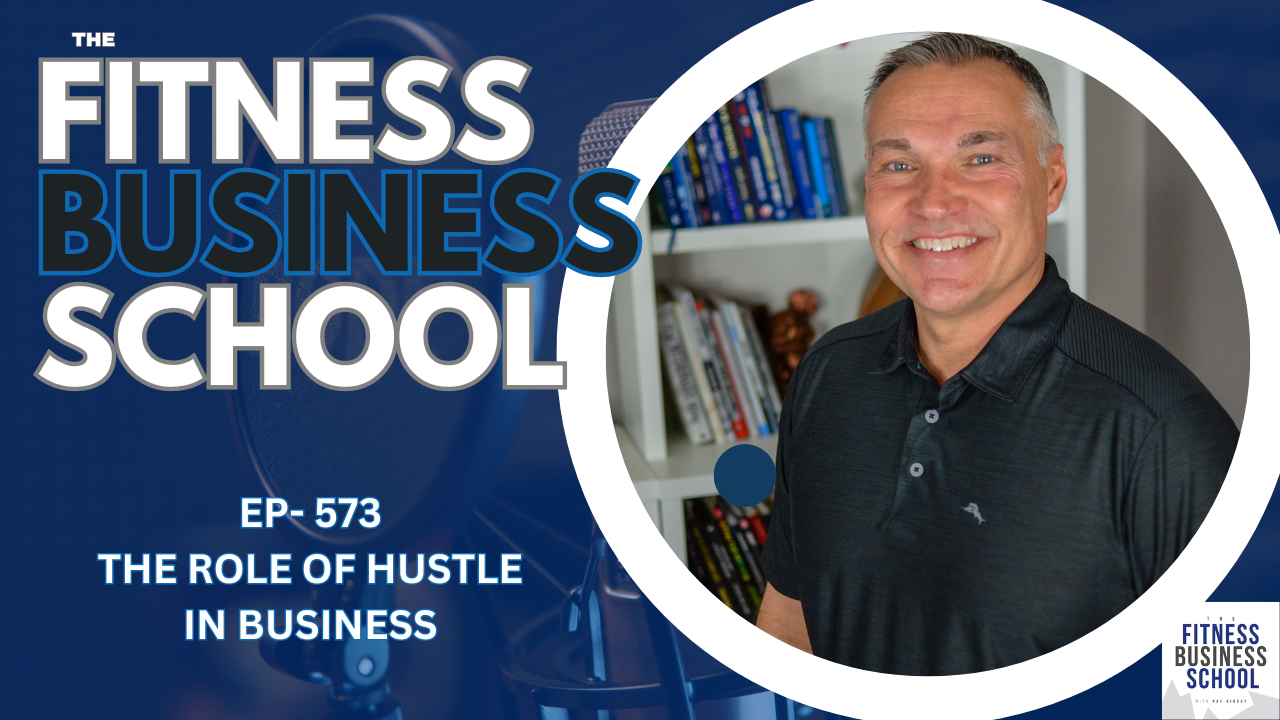Show Notes
00:00 Introduction and Special Offer
00:21 Meet Hank: The Customer Service Expert
01:44 Building a Customer-Centric Business
04:56 Scaling Success: Expanding to Multiple Locations
08:24 Onboarding and Training for Excellence
12:02 Creating Memorable Customer Experiences
16:49 Competing in a Crowded Market
22:12 Sharing Success: Books, Podcasts, and Coaching
26:42 Conclusion and Contact Information
28:48 Special Announcement: Ideal Business Diagnostic
Full Transcript
Welcome to the Fitness Business School podcast, the show for fitness business owners who want to grow their income, increase their impact and improve their lifestyle. Be sure to listen to the end of this episode because we have a brand new special offer exclusive for listeners. So stay tuned.
Hey, Pat Rigsby here again with another episode of the fitness business school podcast and today I have a special guest, Hank. And Hank has really built his career his business, but now an even bigger platform on customer service, customer success, creating a positive customer experience. He’s done it with his own age for training facility, but he’s also started to branch out. He’s got a book, he’s got a podcast.
So tell us a little bit more about you. Yeah. Thanks, Pat. Appreciate you having me on just, as you mentioned, I have a passion for customer service. I think I like to say it’s my business superpower started in hospitality back in college. I actually went to college in Las Vegas. So worked in the Venetian hotel, got that experience right off the bat.
Just. In a wealthier demographic, a higher end facility, hospitality is numero uno when it comes to Las Vegas and learned just the importance of it then, and carried that throughout my whole career to where I am today, which I have H4 training, small group, personal training gyms, just outside of Chicago.
So yeah, everything I’ve built has been based on serving the customer and putting service on the table. Top priority. Let’s start there then. Let’s talk about your training, kind of training business, the boots on the ground stuff outside of Chicago, and then we’ll build on that. So give us a little bit of that backstory.
Yeah. So age four training, we now just celebrate our 10 year anniversary for our first location back in October, seven plus years on our second location. And really, as I mentioned, everything’s just built around a foundation of service. So yes, I think our workouts are great as any gym owner, but I think it’s the way we serve people is what sets us apart.
And we’re a small group based, predominantly women, like a lot of gyms, full body workouts. But we’re not CrossFit, we’re not bootcamp. We’re really that niche of that small group with a personal training emphasis, as we like to call it. So you’ve been able to build two, obviously not only successful, but durable facilities that lasted and they’re rooted in client experience, customer service.
How does that play in a day to day or week to week basis? What makes your approach different? Because obviously, as you had mentioned, most gym owners are going to say, Hey, our programming is great. Our training experience is great. And most of them will probably tell you, hey, get inside our facility.
Our culture, our experience is great too. What makes what you do different? So I think honestly, it’s consistency of the experience. A lot of times gym owners will say we have good experience, good customer service, and it might be some days it might be other days. It might be dependent on who’s working there.
I pride myself on the business that I’ve built has been, can be not dependent on myself. So when we opened our second location, the goal was, can we create that same experience, that same level of service without me ever being there? And I like to think that’s what we’ve done. In fact, when we get client feedback, sometimes our second gym scores higher than our original gym.
Which makes me proud because I’m rarely at that gym, but it stems in what’s called the service vision. So for us, it’s care commitment, community, those listening are familiar with Ritz Carlton. There’s his ladies, gentlemen, taking care of ladies and gentlemen. And that’s the basis of everything we do.
That’s what we hire off of. That’s what we train off of. And that stems from day one of a new hire to as long as they’re with us. So it’s that initial culture and emphasis on service before we just had a new hire. Gosh, maybe two, three weeks ago. And day one of the onboard, he’s are we ever going to talk about lunges or anything to do with exercise.
And I’m like, not for another two weeks. We’re literally going to talk about service, your role, our standards, and how you’re going to play into what we do. So we really emphasize. Hey, we’ll get to those things. But as soon as they’re with us on that day one, they understand, okay, it’s going to be a little bit different here.
Maybe not what I’m used to at other gyms. Okay, nice. So you were able to scale this, you’ve been able to create a service focused atmosphere that extends beyond your own shadow. How did you transplant that? The facility too, right? Because a lot of people I think are really good at. Supervising the details and facilitating some consistency if it’s all under their watchful eye, right?
They see it in, in the day to day. They know what the standards are. They have one facility and they lord over it, for lack of a better way of putting it, and make sure that these standards are met. How did you systemize that to be able to Do that in a second location. One, it is doing just what you said, which is taking the systems and applying those now to that second location, but then having a trusted leader.
So my manager, Taylor, she runs the show at our second location and she started as a trainer. So she worked her way up and essentially she’s implementing everything that we do there and creating that same culture. Now, of course we have. Weekly calls, monthly calls to make sure everything’s where it needs to be.
I’m over there every once in a while, but it’s really just implementing that culture from one place to the other, but then having the right leader to essentially carry it out at that location. That’s the key thing. You have the right person in place from the top that can then bring it to the next level below them.
So knowing who the audience is for this podcast, I’m sure that there has to be some people listening saying great. He found the right person. Have you had any obstacles, pitfalls, challenges along the way in creating this kind of culture, this kind of atmosphere with other people being the boots on the ground or the point people?
Yeah, I think any business, of course, if you’re going to have slip ups you might have the wrong people you hire here and there, and it just throws things slightly off, but it’s how quick then you recover from that. But I really do believe if you have the right systematic approach, in our case, you have the right vision, which are three C’s, everything aligns, the standards are set.
I don’t want to say it’s not as hard as you think, cause it’s definitely not easy. We all know that it’s business, it’s small business, but as long as everything goes back to those standards and you don’t waver from that, I think a lot of gym owners, especially if they have multiple locations, I just got to hurry up and start making money.
We just got to get it open, whatever. I’ll just throw someone in there. We got to get going. It’s rushed. And then sometimes they. They’ll overlook something or they’ll just, whatever. Let’s just get them on the floor. Let’s not train them properly. They don’t quite meet the standards, but I got to start making money or we just need to fill the void and they maybe have the intentions.
Of what they did early on when they started gym one in month one and they just waver too far So I think it takes discipline And the mentality of a little more patience Than maybe some gym owners have so In a real kind of granular sense. How does this look from? onboarding a new hire on to The weekly facilitation and execution of this stuff.
Yeah. So absolutely we could spend hours on this subject, but just to give you a basic form of it for us, once we find the right person, go through our hiring process of phone screen and in person, and we do a day in the life of, to see if they gel with the team and just naturally want to see them in our environment.
Once they get past that, we bring them on board. Our onboard, especially from day one to day two is literally strictly not one ounce of training talk, nothing about how we coach, nothing about the workouts, our formats. It’s strictly laying the foundation for our service vision, our standards, which we have 13 service standards.
And then we talk about examples of those standards from our current team and previous team members. So we’ll go through. Give examples so they can go line. Okay, this is what that looks like. This is then how I play that role. And it’s just a lot of that on day one and two. We really want to lay that foundation and it’s really teach an individual how to build relationships with clients.
What does that look like? We use something called FORD, an acronym, so it’s Family, Occupation, Recreation, and Dreams. That’s what we use to help them build relationships with individuals. And day one and two is strictly spent on foundations of service, our vision. And then after that, it’s just a slow on ramp of Observations, focus on relationship building, service delivery.
And then after about two, three weeks in, we slowly start to incorporate how to run our systems training wise, how to coach sessions, but it’s a slow ramp up to make sure we don’t rush past what we think is the most important part. And. That first, whatever, a few weeks, people are like sponges. That’s the time you gotta get them into your culture versus just throwing a book at them.
Let them, Hey, this is our book. Read about it or go talk to so and like we want to make sure we’re entrenching you in our core values when it comes to service. And making sure it’s known as a priority. Do you do weekly team meetings monthly team meetings? How does that kind of ongoing facilitation work?
Yeah. So we used to do every week and we, since I’ve shifted with
the thought of our coaches in mind, that it started to get a little too much. And maybe those listening know, Hey, your coaches have lives. They might have other gigs. In fact, they probably do have other gigs. So we switched it to every other, and again, the service emphasis leads every meeting.
We start off every single meeting talking about anything that’s happened to illustrate our standards. We talk about our surprise and delight budget. So we bring that up. If anyone has ideas on that front and then every month we give away, we call it our customer service superhero belt. So it looks like a WWE belt.
It was custom made. So it just has a big superhero logo on there. And we give that away to who we think. Really stood out to us live and breathing our standards extra special for that month. So every other week, and again, the main emphasis in the beginning of every meeting is service. Before we talk about anything else, sales, marketing client, it leads our meetings.
So I know in my case, because I’m, I just am immersed in the business stuff so much. I tend to notice, What other businesses are doing a little bit more have there been any service experiences you’ve had it as a customer a client a patient that have really stood out to you that helped influence your way of thinking.
I think Ritz Carlton, I know they’re a huge chain and everybody knows about them, but we tried to take their whole philosophy on surprise and the light, which if those of you listening aren’t sure what that is or what they do, essentially They allot each team member of theirs 2,500 to surprise and delight customers.
That could mean somebody left something in one of their hotel rooms and lost it. And they might send it to them. They might replace something. It’s someone’s anniversary. They send up chocolates. And the key is. Everybody’s allotted that amount of money and they’re encouraged and they’re never yelled at or discouraged for doing that for anybody.
So I pride myself and we took that and we basically scaled it to a way smaller business with a way smaller budget and a way smaller amount of staff. And so that’s what we’ve created. So I think we’re able to systemize that to both locations. To have it be consistent. So I would say, honestly, that’s probably been the biggest influence is the Ritz Carlton.
Very cool. So give me an example of just one thing that a team member did to surprise and delight a client. So I can give you a 20, but we’ll, I’ll give you a couple. So one actually, I love to tell a story. We’ve probably all had that client who, They’re like perfect, right? They come in, they’re lit up, they love training, they have the best attitude.
They’re just, they’re ready to go every time they come in for the session. That’s like the ideal person. This was our client Julie and she came in one day. The opposite head down. You could just tell she was off. It just was not her normal self. And Hey, Julie, what’s going on? You just, you seem a little bit off today and she just went on this huge rant.
My kids are just going nuts this morning. I woke up late. The dog was freaking out. And she goes, the worst thing is I have probably the most important presentation of my life this afternoon. And she goes, you guys know, if I don’t get my coffee, I’m just like, my day’s ruined. And she goes, I didn’t have my coffee.
The morning just got away from me. And so the session’s going on, we’re about 20 minutes before the session’s going to end. One of our interns there was with one of our coaches and our coach said, Hey, you know what? Take the card, go run to Starbucks. We know what she likes, go grab her that skinny latte.
So intern runs, goes and gets it, comes back. We put smiley face, put her name up on the counter. Session comes to an end. She comes over to the front desk. You would’ve thought we put just mounds of hundred dollar bills on the desk. She was just what is this? We said it’s your skinny latte.
It’s your favorite drink. And we know if you don’t have your latte, your day’s ruined. And it sounds like you probably have a pretty important day. We don’t want your day to be ruined. We want to help you flip the script from when he came in. And again, you would’ve thought we put stacks of hundreds, which I guess it was Starbucks, so it basically was the same thing, right?
But so she took the drink, she went on with her day about two hours, three hours later, she wrote me a great email, just killed the presentation. Thanks for the coffee. Two more hours later, she put up a post on Facebook. Couldn’t have handcrafted a better ad myself if I tried. She put a picture of the coffee with herself and wrote this.
Essay of a post, just, Hey, I bet your gym doesn’t do this. This is what my gym did. I killed my presentation and just went on and on. And the moral of the story was, Hey, we saw the opportunity. We took advantage and it led to the best marketing I think ever could have paid for design myself. So that’s a perfect example of a coach seeing that opportunity.
I always like to say, Hey, just cause your clients have a bad day. It doesn’t mean you go buy everybody coffee, but does your team look for the opportunities? And are they empowered to then do that opportunity to create that moment? And are you going to come down on them as a leader? Why’d you do that? Why did you spend that money?
You shouldn’t have done that. Ask me next time. It can’t be any of those things. It just has to be. Empowered to do that. And that’s why we have a monthly budget for it to do just that. So you touched on something in her post, the bet your gym doesn’t do that piece of it. Obviously we’re at an interesting period in the fitness industry because yeah, you’ve been doing this for a while.
You’ve got a facility that’s over 10 years old now, 15, 20 years ago, there weren’t. There weren’t franchises on every corner. There weren’t not only group training franchises, traditional, the bootcamp esque things, large group training, but now there’s specialty franchises for everything from cycling to Pilates to yoga.
How does this sort of approach play into you? Obviously competing successfully. Against the ever growing competitive landscape. Yeah, I think it creates the, all I like to think of as the ultimate competitive advantage because everybody can steal your workouts. They can steal your equipment. Nobody can steal how you make people feel.
And that sometimes that sounds cheesy and yeah, whatever, but it’s true as gym nerds that we all are, we think nobody does workouts like we do. And we have the coolest workouts or nobody has our equipment. That’s just not the case. You could open up next to me and steal everything we do, but you’re just not going to pry create the culture, make your clients feel how we make ours feel.
So to me, it’s the easiest competitive advantage you can have. And probably the most overlooked aspect of it. I’m always amazed when people call us and they’re just. Amazed that we respond in a rapid timeframe, the basics of customer service, the foundations that so many places don’t even do. How many gyms, you probably know this Pat, make you jump through a million hoops just to cancel a membership.
You have to prove you’re still alive and living to cancel that it’s like insane. So there’s so many things as a gym owner, you can do that help you stand out because. Most of the gyms out there, they make it tough on you. They’re not very customer centric and they put so much focus on, Oh, we just have the coolest workouts.
What do you do? Yeah, it’s definitely a really interesting kind of. And I think you’re spot on. It provides a distinct competitive advantage because when I would have been early on in my journey here, it was not uncommon for gyms to say, Oh, send us a letter certified mail for your cancellation or something like that.
And the only, Consequence they would face would be, Oh, maybe somebody would report them to the better business bureau that 99 percent of potential clients or members would never look at anyway. But now, reviews are front and center on the way that people make decisions. I think that even if somebody sees an ad on social media or something for your facility, a lot of times they’re going to jump back and look at your Google business listing and look at the reviews and look at the comments.
They’re going to look at what people. say on your business page and see what the feedback is and see what the client experience was. And so you’re just building kind of brick by brick that this portfolio of positive client experiences that turn into marketing material, even if they’re not initially designed to be that.
And then I know philosophically, I think we’ve graduated to a place where retention, both retention physically of somebody staying in your facility, but then retention of somebody’s attention with so many different things vying for that attention is just getting harder and treating somebody in a really unique and special way that makes them feel important and valued and appreciated rather than being transactional is probably the surest way to, to retain.
Both their membership, but then also their goodwill and their attention. Yeah. I think a lot of say business owners in general, not just gym owners tend to look I got to just do more ads, right? I’m going to do more ads. I got to get out there and sell. That’s obviously important, but you can look at customer service as not something you just do or that just happens, but it actually can be.
A revenue generator, right? But a lot of businesses, it becomes a revenue detractor. They might be getting tons of people in the door. Their marketing’s killing it, but if they’re just going right back out the back end, it really doesn’t matter how many people you’re getting in the door. If they’re leaving just as fast, I rather have less coming in, but nobody really going out the back door because you can actually take care of them.
And so many, I think gym owners just, they’re just chasing next person next. And it’s hold on a second. Like people you actually have right now paying you that are actually in your gym in front of you let’s make sure we’re taking care of them and not just their first week there in their first month, and you push them to the side to go chase the next lead.
But let’s make sure we’re taking care of them throughout their entire. Time with you, not just that rushed suite. We got them. Let’s move on so I can go get the next 10, 20, 30 leads. So let’s kind of pivot. If you will, you started to take some of the things that have worked so well in your facilities and share them through a success trials podcast.
You’ve written a book, you’ve done a course, talk a little bit more about how you’ve, maybe bottled up in some way some of the things that you’ve done well in your business and shared it with other owners Yeah, so it honestly actually started. We have a lot of entrepreneur clients and one of our clients one day just said, Hey, I’ve been here for six years.
It doesn’t matter who’s working for you, whether they’re new, they’ve been here for five years. I feel like I always get the same consistent level of service, whether you’re here or not. You’re not here. What are you guys doing? And so one day I went to meet with her and we just broke down exactly our process.
And then another client asked about it a couple of months later, and it slowly started to get some momentum okay maybe people are asking what we’re doing. We must have a good process and just started tightening up that what is our true process. And so I came up with, I call. LTS, which stands for leadership team systems and strategies.
And that LTS, when you put it into play and everything has a role and everything has to do with one another, you can create that Ritz Carlton level service. I like to call it superhero level service within your business. And so started to create that process, started helping more and more businesses. Not just gym owners, but insurance agency.
My one client was a restaurant owner. The original client was an HVAC guy who had a, that service based business and started to see, Hey, you know what? This stuff carries over across all types of businesses and it’s really based about principles. So that’s how it started. And that’s where it is today.
Yeah. I think that sometimes people in our industry get a little bit myopic and they only really look at. What’s happening in industry. And I would say that 98 percent of the things that I’ve learned that have allowed me to improve have been things that I’ve pulled from other sources, other industries, other leaders, other entrepreneurs outside of fitness and figured out how to adapt them here.
And it looks like not only have you done that referencing your time in Vegas, the Ritz Carlton, the Venetian. But then now you’re. Doing the same thing for people outside of the fitness industry as well as people in industry Yeah, we’re all dealing with people and so I don’t know that the tactical piece of it Should take up as much of our time and real estate The human element.
And it seems like you’ve really done well with that for sure. So talk a little bit about the book as somebody who’s very much a, an avid reader. What compelled you to write a book and start to share some of this stuff? Actually wrote it over COVID. So as everybody knows, it was a time where you’re stuck inside.
It’s a perfect opportunity to check things off your list. And that was one of the things I wanted to do was create something that I could share with others, business owners, particularly, obviously gym owners. And I wanted to share that method that I started to create, which is. Call the LTS method, but I wanted it to be a book that was not a 300 pages.
That was not a boring black and white typical business book. And I also wanted it to be something that could be read quickly. Cause as you definitely know, we’re all very busy and we have very short attention spans, especially us trainers. We’re definitely not the best people to sit down and spend three hours diving into something.
So I kept it short, kept it sweet, gave it a comic book, bright vibe to it. And wanted to just give a basic kind of ground. Foundational approach to somebody to build that Ritz Carlton level culture. What are the best of the best businesses doing? How do they create those service first cultures?
And I wanted someone to be able to read it quick and start implementing it right away as quick as they could. Nice. So So to bring all this together you’ve got two good facilities, you’ve got a podcast, you’ve got a book, you’re doing some coaching work with people in industry, out of industry.
What’s next for you? To be honest, it’s just to get out there and help more businesses. I tend to notice, I love the gym business, but I actually enjoy more just the coaching aspect of it and coaching other gym owners, business owners to really help transform them in terms of from a maybe non service based focused business to a service.
based business no matter what the industry is. So I just want to continue to expand that, continue to speak more, and maybe down the road, we’ll expand the H4 brand, but starting to take a little more route into the actual coaching side of things. Gotcha. So if somebody wants to learn more about you, what you have going on, where can they find you?
Yeah, I’m sure you guys might have some show notes or links below, so I’m sure you might have something there, but if not, you can find me on all social media platforms, Hank Ebeling, Spend most of my time on LinkedIn and Instagram. You could shoot me an email. [email protected]. Love to connect, learn about your business.
I try to do as much posts as I can about service. So jump on, hopefully I can provide value to you and help you even if we don’t work together directly. Sounds good. So yeah, we’ll have some links in the notes. We’ll have your bio there so people can learn a little bit more about you, but thanks Hank for making the time today to share some of your back stories, some of how you’ve been able to use service to, to really build a, like I said, successful and durable business when, let’s face it, most small businesses don’t last for 10 years, seven years.
So you’ve done something special there. And now you’re packaging that up and disseminating it everywhere else. So thanks for sharing. Yeah. Thanks Pat. And as myself and the listeners know, you’re a legend, obviously in our industry. So thank you for what you do and appreciate you for having me on. Awesome.
Thanks for listening to this episode of The Fitness Business School.
Before you go, I have a quick announcement:
One of of the things that we’ve been doing with our current clients is taking them through this Ideal Business diagnostic and really what it is, this checklist that allows you to pinpoint exactly what your business needs next so you can keep improving, keep growing, and build a business that you love to own, one that pays you well, one that allows you to have the impact you wanna have and one that allows you to have a lifestyle that you truly enjoy.
In this diagnostic, we walk through everything and we do an evaluation and can instantly pinpoint what you need to do next to build that business that you want. I’m going to extend this opportunity to get on with either me or my team and take you through this evaluation and fix your business’s most vital needs fast.
So if we take you through this, you’re gonna be able to make those vital changes that you need to finally have what I call your Ideal Business. If you’d be interested in going through this entirely free, risk-free diagnostic with us and learn what you already have in place, what you’re doing well and where are your greatest opportunities for rapid improvement are just shoot me an email with diagnostic in the subject line to [email protected].
Again, an email to [email protected] with diagnostic in the subject line will get
you scheduled and take you through this evaluation to help you build the business you want.
